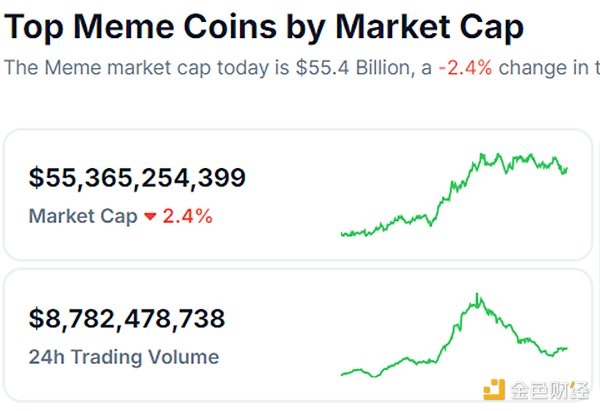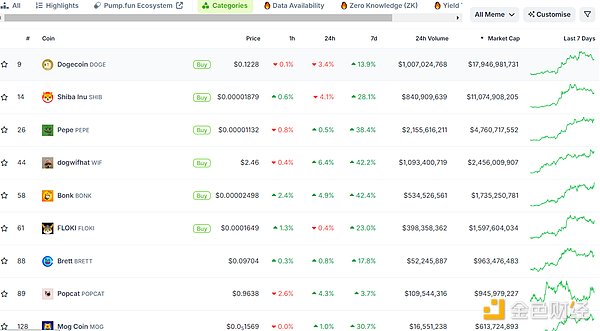Author: Climber, Golden Finance
Since the beginning of 2024, the crypto market has generally lacked innovative narratives compared to previous years. Although various new technologies and new tools have emerged one after another, except for some popular track sectors, most of them have performed mediocrely. On the one hand, this is affected by the decline in the crypto market, and on the other hand, it is also a reflection of the lack of innovation in Web3.
However, there are often cases in the crypto market where new narratives suddenly break out after lurking. For example, last year the inscription sector experienced a trend of climbing from the bottom to the peak. In addition, market funds usually prefer new concepts, and the investment logic of speculating on new things rather than old ones needs to pay more attention to new things. Based on this, Golden Finance has sorted out the major popular narratives and new technologies that have emerged since this year to help investors prepare in advance when wealth opportunities come.
1. Bitcoin Ecosystem
1. Bitcoin Rune
Bitcoin Rune is a protocol that can create homogeneous tokens on the Bitcoin blockchain. Unlike BRC-20 and SRC-20 tokens that also run on the Bitcoin blockchain, Bitcoin Rune does not rely on the Ordinals protocol and is simpler and more efficient. They utilize established Bitcoin blockchain models, such as the UTXO model and the OP_RETURN opcode.
Compared with BRC-20 tokens:
In terms of the operating model, Bitcoin Rune operates based on Bitcoin's unspent transaction output (UTXO) model. In contrast, BRC-20 tokens operate on the Bitcoin ordinal protocol, which allows data to be attached directly to individual sats.
In terms of token transfers, Bitcoin Runes uses a transfer mechanism whereby a transaction creates a new set of UTXOs based on the data stored in the OP_RETURN field of a Bitcoin transaction. In contrast, BRC-20 token transfers require the creation of a new Inscription for each transaction.
In terms of token minting, Runes can be minted through an open or closed minting process, with developers also having the option of pre-mining. In contrast, BRC-20 tokens can only be minted through an open minting process, which limits the flexibility of how tokens are initially distributed.
In terms of management, the Bitcoin Rune protocol is compatible with the Bitcoin Lightning Network, supporting both Lightning Network clients and Simple Payment Verification (SPV) wallets. In contrast, BRC-20 tokens are only available for wallets that support the ordinal protocol.
2. Fractal Bitcoin
Fractal Bitcoin is a Layer 1 solution designed specifically for expanding the Bitcoin network. Unlike other expansion technologies, Fractal Bitcoin uses a tree-like recursive expansion layer structure (BCSP, i.e., blockchain expansion protocol) to increase the transaction processing speed and efficiency of Bitcoin by adding layers.
In summary, Fractal Bitcoin is a forked version based on Bitcoin Core v24.0.1 and can be regarded as a small Bitcoin chain with adjusted parameters. Its main differences include block time, difficulty adjustment mechanism, total token amount (the total token amount set by Fractal Bitcoin is 210 million), initial block reward, halving cycle, and activation of OP CAT opcodes.
Eco-projects: Cat Protocol, Pizza Swap, Uni Worlds, Satspump.fun, Infinity AI
3. Bitcoin NFT Protocol Bitcoin Stamps
Bitcoin stamps are digital art generated through the Bitcoin Stamps Protocol, a method of incorporating digital art into the Bitcoin blockchain. The protocol encodes data in unspent transaction outputs (UTXO) and ensures the immutability of the data by permanently adding it to the blockchain.
Bitcoin stamps mainly use two protocols: SRC-20 and SRC-721.
1. SRC-20. The SRC-20 token standard is created based on the open Counterparty protocol. This standard embeds arbitrary data into spendable data transactions, which is different from the ordinal protocol that places data in the witness section.
2. SRC-721. The SRC-721 standard reduces the cost of creating detailed NFTs. The standard uses the Bitcoin Stamp Protocol to store images in layers, reducing file size by indexing color palettes for each layer, among other methods. These layers can be merged into one NFT, resulting in high-quality images without incurring high costs.
Second, TONEcosystem
The Open Network (TON) is a decentralized and open Internet platform consisting of multiple components. These components include: TON blockchain, TON DNS, TON storage, and TON website. The TON blockchain is the core protocol that connects the underlying infrastructure of TON, thus forming a larger TON ecosystem.
TON is committed to achieving extensive cross-chain interoperability while operating within a highly scalable security framework. TON is designed to process millions of transactions per second (TPS), with the goal of ultimately reaching hundreds of millions of users.
The TON blockchain is designed as a distributed supercomputer, or "super server," to provide a variety of products and services to power the decentralized vision of the new Internet.
Eco-projects:
Memecoin: Notcoin, DOGS, Catizen, Hamster Kombat
DeFi: DeDust, STON.fi, Tonstakers, Stakee, Whale Liquid, EVAA
Oracle: RedStone
3. Restaking
Restaking is a way to pledge the same tokens on the main blockchain and other protocols to earn rewards, thereby ensuring the security of multiple networks at the same time. Restaking provides users with additional rewards to protect other protocols in exchange for taking on higher penalty risks (Slash). Restaking is a decentralized pledge asset management method pioneered by EigenLayer.
Re-staking goes a step further than liquidity staking, supporting users to stake assets multiple times on their original blockchain and other protocols. For example, EigenLayer supports Ethereum stakers to reuse their staked ETH to protect other applications built on the network. Stakers can choose additional services they want to obtain with their currently staked ETH and earn additional income from them. In return, they agree to grant EigenLayer additional slashing rights on their staked ETH (in addition to the slashing rights of the underlying Ethereum staking contract).
In essence, the re-staking protocol provides a set of smart contracts that support staked tokens to be reused and pledged again (i.e., re-staking) to provide security for applications outside the original blockchain.
Representative projects: EigenLayer, Ether.fi, Puffer Finance, Swell, Renzo, AltLayer.
Other on-chain re-staking projects: Picasso (Solana re-staking) and Babylon (Bitcoin staking).
Fourth, MEMECoin New Force
According to CoinGecko data, on September 14, 2023, the total market value of global cryptocurrencies was approximately 1.34 trillion, and the total market value of the meme sector was approximately 20.8 billion. On September 30, 2024, the total market value of global cryptocurrencies was approximately 2.242 trillion, and the total market value of the meme sector was approximately 55.4 billion (US dollars).


In addition, there are currently 8 meme currencies with a market value of over US$900 million.
Launch platform: Solana ecosystem project Pump.fun, Ethereum ecosystem Ethervista, TRON ecosystem SunPump, Bitcoin ecosystem Ticket.fans, Burve Protocol, Dexscreener launched Moonshot, Base ecosystem We.Rich,
Popular currencies: Neiro, WIF, Turbo, MGAG, TRUMP, Kamala Horris (KAMA), MooDeng, TERMINUS
V. Token standards
1. ERC404 protocol:
ERC404 protocol is an experimental, hybrid ERC20/ERC721 implementation with native liquidity and fragmentation. That is, the protocol allows NFTs to be split and traded like tokens. It is a currency swap protocol with native liquidity and fragmented protocols.
Pandora is the first project built on the ERC-404 token standard, which is used to mint 10,000 Replicant NFTs, which are linked to 10,000 ERC-20 tokens. After purchasing PANDORA tokens, users will receive the minted NFTs in their wallets. The price of the token was as high as $32,000 per unit on February 9, but the current price is only $1,500.
The ERC-404 standard is still in the experimental stage, so many challenges need to be solved before it becomes a mainstream technology. The new standard will inevitably require the introduction of large-scale technical upgrades in blockchain networks and applications, and will also cause security issues due to potential defects and vulnerabilities in the new technical standards.
2. Atomicals Protocol:
Atomicals is a free, open-source protocol that supports the creation of digital objects on Bitcoin or any other blockchain that uses the same unspent transaction output (UTXO) model. Each digital object is called an "atom" and is essentially composed of a chain of digital ownership that follows a simple set of rules.
The Atomicals protocol can be used to mint, transfer, and update various types of static or dynamic digital objects, including fungible tokens and non-fungible tokens (NFTs). Atoms are created through Bitcoin transactions, and the protocol is compatible with any Bitcoin wallet without the need for a separate chain, Layer 2 network, or third-party services.
ARC-20 is built on the Atomicals protocol and is an experimental token standard for fungible tokens (coloring ratios) on the Bitcoin network.
Six, Zero-Knowledge Solution
ZKThreads
Layer 2 developer StarkWare, together with Cartridge, has launched a new scaling framework called ZKThreads to improve the scalability of decentralized applications on the Layer 2 network Starknet through execution sharding enabled by zero-knowledge proofs. This is based on StarkWare's sharding scaling vision launched in 2021.
ZKThreads is a zero-knowledge framework that improves DApp performance and scalability. The framework leverages the power of Starknet to create a standardized environment for developing and running interoperable applications on blockchains.
In terms of data processing, ZKThreads aims to store state and transaction data off-chain, while using zero-knowledge proofs (ZKP) to verify transactions. This is different from many traditional zero-knowledge rollups (zk-rollup), which move computations to off-chain processing but still store transaction data on-chain.
In terms of interoperability, ZKThreads prioritizes interoperable applications, reduces fragmentation, and ensures that various DApps can interact smoothly in the same ecosystem. In contrast, other solutions such as zkEVM focus more on compatibility.
In terms of verification mechanism, ZKThreads' verification process includes creating STARK proofs to verify the correctness of batch transactions and state changes. These proofs are then verified based on the specification status of the DApp. In contrast, zero-knowledge aggregations such as zkSync use zk-SNARK or zk-STARK to create cryptographic proofs that are verified on the chain.
Summary
There are relatively few new narratives that have emerged this year. Only the MEME concept and TON ecology are relatively eye-catching. Other narratives such as Bitcoin ecology, re-staking, and expansion plans lack wealth effects. Previously, some analysis agencies believed that part of the reason is that there are many ecological projects in the current crypto market track sector, but liquidity funds are limited. Therefore, if new narratives want to flourish, they still need the help of more funds. What investors have to do is to plan ahead. After all, wealth always comes to those who are prepared.
 Joy
Joy








